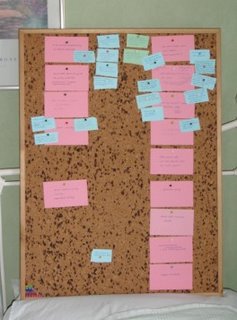
See? A big gaping black hole at the beginning of Act 2. (Top left is plot point 1, and then they descend in two colomns to the bottom right, where "happy ever after" is wrtitten). I know some writers prefer not to know what's coming up, but I definitely need a basic idea of my plot. I can't seem to start writing knowing that the black hole is there. But I must remind myself that I always get stuck at this point.
A great book to read on three-act structure is Linda Seger's "How to Make A Good Script Great". I know the book is mainly about screenplays, but it is relevent to the novel writer too. I'm a structure-junkie and I liked the idea of having three acts to the story, like a play.
Act one: this is the part where you set up the story and introuduce the characters. At the end of Act one there is a turning point which leads the action on to...
Act two: the story moves off in a new direction. Plot develops, characters deepen. A turning point (more dramatic than the last) leads to...
Act three: the final section of the story with a climax and resolution.
Most stories can be split into three acts, basically meaning that good stories have a beginning, a middle and an end. I found using the three act structure useful when plotting as it stops me meandering all over the place with no clear direction. I don't need to know all the small details of the plot before I start, but it helps if I know the basics - what Linda Seger calls the story "spine".
I see it more as a skeleton myself. The basic structure is there, but it isn't until I write a particular scene that I start to flesh that part out, knowing its feeling and texture and how it joins to other parts of the story.
The best advice I heard regarding plotting was at a workshop at the RNA conference last year for members of the New Writers' Scheme: plot is not just a series of events, there should be a chain of cause and effect. So, I could think to myself, "What could go wrong on Adele and Nick's journey?"and come up with various ideas: running out of petrol, taking a wrong turning, having an accident. But if I throw all of these ideas in, it will just feel disjointed and episodic.
There should be a reason why certain things happen e.g. they take a wrong turn because they are arguing about Adele's driving and she's not paying attention. Then they run out of petrol because they've ended up miles down a country road with no petrol stations in sight. "Because" is an important word in plotting. Now, I may or may not use these ideas, but it makes a lot more sense than just flinging every idea into the pot.
So, I'm off back to my plot board to see where the actions and reactions of the characters are going to take me...

4 comments:
I've never thought of books as having "acts" before, but that's a really simple and straightforward way of looking at it. Thanks for the tip! :)
Fiona, how do your chapters fit into each act?
I have my act 1 end at the end of chapter 3
Act 2 is chapters 4-8 and maybe part of 9
and act 3 finishes at the end of chapter 10.
How about you? Do you write 10 chapters or 12?
Janet
Janet, I'm afraid I have no ability to plan chapters at all. I tend to write the scenes that need to be written, and when I've reached the right kind of word count, I end the chapter and start the next one.
My first book had 5000ish word chapters, so it broadly fell into the outline you mentioned. Book two had fifteen 3500-4500 chapters, and I have no idea where the Acts fell in terms of chapters - only in terms of events.
But, one thing I've realised as I talk to other writers, is that no two do it the same. It's all about what works for you at the end of the day.
Fiona,
that board looks very impressive!
What are the blue and green cards?
I'm intrigued by this whole process...
Post a Comment